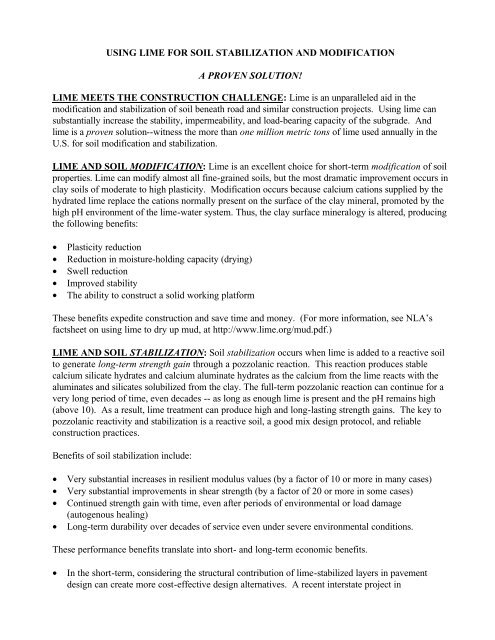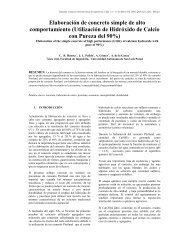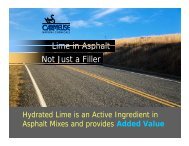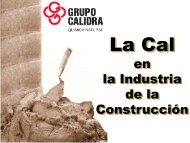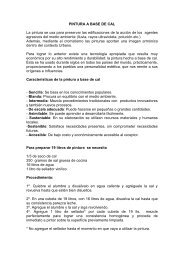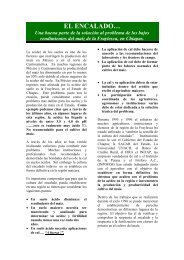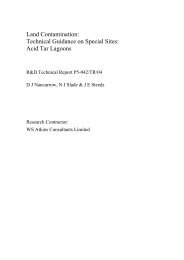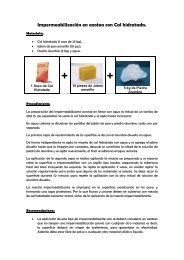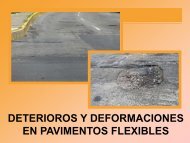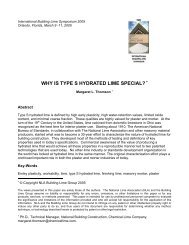USING LIME FOR SOIL STABILIZATION AND MODIFICATION A ...
USING LIME FOR SOIL STABILIZATION AND MODIFICATION A ...
USING LIME FOR SOIL STABILIZATION AND MODIFICATION A ...
Create successful ePaper yourself
Turn your PDF publications into a flip-book with our unique Google optimized e-Paper software.
<strong>USING</strong> <strong>LIME</strong> <strong>FOR</strong> <strong>SOIL</strong> <strong>STABILIZATION</strong> <strong>AND</strong> <strong>MODIFICATION</strong>A PROVEN SOLUTION!<strong>LIME</strong> MEETS THE CONSTRUCTION CHALLENGE: Lime is an unparalleled aid in themodification and stabilization of soil beneath road and similar construction projects. Using lime cansubstantially increase the stability, impermeability, and load-bearing capacity of the subgrade. Andlime is a proven solution--witness the more than one million metric tons of lime used annually in theU.S. for soil modification and stabilization.<strong>LIME</strong> <strong>AND</strong> <strong>SOIL</strong> <strong>MODIFICATION</strong>: Lime is an excellent choice for short-term modification of soilproperties. Lime can modify almost all fine-grained soils, but the most dramatic improvement occurs inclay soils of moderate to high plasticity. Modification occurs because calcium cations supplied by thehydrated lime replace the cations normally present on the surface of the clay mineral, promoted by thehigh pH environment of the lime-water system. Thus, the clay surface mineralogy is altered, producingthe following benefits:• Plasticity reduction• Reduction in moisture-holding capacity (drying)• Swell reduction• Improved stability• The ability to construct a solid working platformThese benefits expedite construction and save time and money. (For more information, see NLA’sfactsheet on using lime to dry up mud, at http://www.lime.org/mud.pdf.)<strong>LIME</strong> <strong>AND</strong> <strong>SOIL</strong> <strong>STABILIZATION</strong>: Soil stabilization occurs when lime is added to a reactive soilto generate long-term strength gain through a pozzolanic reaction. This reaction produces stablecalcium silicate hydrates and calcium aluminate hydrates as the calcium from the lime reacts with thealuminates and silicates solubilized from the clay. The full-term pozzolanic reaction can continue for avery long period of time, even decades -- as long as enough lime is present and the pH remains high(above 10). As a result, lime treatment can produce high and long-lasting strength gains. The key topozzolanic reactivity and stabilization is a reactive soil, a good mix design protocol, and reliableconstruction practices.Benefits of soil stabilization include:• Very substantial increases in resilient modulus values (by a factor of 10 or more in many cases)• Very substantial improvements in shear strength (by a factor of 20 or more in some cases)• Continued strength gain with time, even after periods of environmental or load damage(autogenous healing)• Long-term durability over decades of service even under severe environmental conditions.These performance benefits translate into short- and long-term economic benefits.• In the short-term, considering the structural contribution of lime-stabilized layers in pavementdesign can create more cost-effective design alternatives. A recent interstate project in
Updated March 2001Page 2Pennsylvania, for example, began with a $29.3 million traditional design approach. An alternatedesign using lime stabilization, consistent with AASHTO mechanistic-empirical designs, cost only$21.6 million—more than 25 percent savings! (Qubain et al., Incorporating Subgrade LimeStabilization into Pavement Design, Transportation Research Board Meeting, January 2000.)• In the longer term, lime stabilization provides performance benefits that reduce maintenance costs.To illustrate, stabilizing an 8-inch native clay subgrade with lime as part of an asphalt pavementproject can reduce 30-year life cycle costs from $24.49 to $22.47 per square yard (from a life cyclemethodology illustration in Stabilization of Pavement Subgrades & Base Courses with Lime, seebelow).In addition to stabilization of new materials, lime is an excellent choice for the reclamation ofroadbases. As more and more governmental entities are choosing to reclaim existing roadbases ratherthan replace them, this use of lime will become even more important.Lime stabilization is not difficult to carry out. After proper mix design and testing is performed, inplacemixing is usually used to add the appropriate amount of lime to soil, mixed to an appropriatedepth. Pulverization and mixing is used to thoroughly combine the lime and soil. For heavy clays,preliminary mixing may be followed by 24 to 48 hours (or more) of moist curing, followed by finalmixing. For maximum development of strength and durability, proper compaction is necessary.Proper curing is also important. If sulfates are present at levels greater than 0.3 percent, specialprocedures are required.Additional details on mixture design and testing protocols appear in NLA’s Evaluation of StructuralProperties of Lime Stabilized Soils and Aggregates, Volume 3: Mixture Design and Testing Protocolfor Lime Stabilized Soils, by Dr. Dallas N. Little of Texas A&M University (see reference list below).Other methods of lime stabilization include in-plant mixing and pressure injection.For more information, including technical papers on soil stabilization, check NLA’s website athttp://www.lime.org. Several useful documents can be downloaded free of charge and others can beordered online, including:• Evaluation of Structural Properties of Lime Stabilized Soils and Aggregates (3 volumes)• Fundamentals of the Stabilization of Soil with Lime• Lime Stabilization Construction Manual• Guidelines for Stabilization of Soils Containing Sulfates• A Long Range Durability Study of Lime Stabilized Bases• Lime Slurry Pressure Injection Manual• Stabilization of Pavement Subgrades & Base Courses with Lime• Lime Dries Up MudNational Lime Association200 N. Glebe Road, Suite 800Arlington, Virginia 22203-3728Phone: 703-243-5463; Fax: 703-243-5489E-Mail: natlime@lime.orgWeb Address: http://www.lime.org


